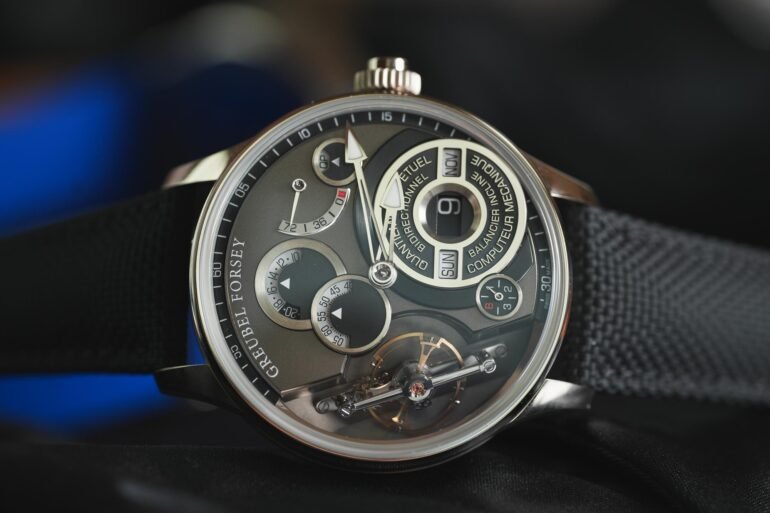If you ever have the chance to try on a Greubel Forsey — any Greubel Forsey — take it. For one thing, these are rare watches, and it’s a cool thing to be able to say you’ve done. For another, Greubel makes objectively awesome watches, and any watch enthusiast should try out as many awesome watches as they can. But more important than that, Greubel Forsey is one of those brands whose quality is hard to understand through the internet.
Greubel Forsey is a brand that defies expectation. Since the launch of Greubel’s first watch in 2004, Greubel Forsey has pushed the limits of both technical and aesthetic watchmaking, and they’ve done it all without sacrificing their unique character, or seemingly ever needing to compromise. In fact, the Greubel Forsey of today is — at least outwardly — a brand with a clearer identity than most, that also happens to do what it does really, really well.
A few weeks ago, in Geneva, our two Zachs had the chance to sit down with the brand to see the proof of that in person, and to catch up on some of Greubel’s latest releases, including the brand new QP Balancier and the new Nano Foudroyante — a direct successor to last year’s superb Nano Foudroyante EWT — each of which have been announced in highly limited editions of 22 watches, and each of which are great reminders of just how far Greubel has come in the last 25 years. It also doesn’t hurt that both the QP Balancier and the Nano Foudroyante easily rank among the most covetable watches of the year.
First up, let’s take a look at the QP Balancier, a perpetual calendar wristwatch that draws from the earlier QP à Équation, introduced a decade ago. Like that watch, the QP Balancier is built around the Computer Mécanique, a mechanical computer that lets the user set the perpetual calendar forwards or backwards entirely through the crown, without having to consider the time of day, all without having to stress about breaking what is typically a very delicate complication — something which, from an end-user perspective, makes for a much more usable watch.
Of course, an incredible perpetual calendar isn’t enough to set apart the QP Balancier alone (after all, you can get a Moser Perpetual Calendar with similarly worry-free setting for a fraction of the price of the QP Balancier, though that movement still uses a push adjuster on the side — the QP Balancier is set entirely from the crown), so GF’s latest also includes the brand’s hallmark 30-degree inclined escapement, though gone here is the tourbillon featured on the QP à Équation. It’s a sacrifice made in the name of simplicity, and one that I’m on board with, especially when the result is what I’d argue is one of Greubel’s more successful (and aesthetically accessible) designs.
It’s a surprisingly legible take on a perpetual calendar layout, with a clean interface that puts the important parts of the calendar on full display (okay, maybe not full — the year is only visible through the curved sapphire caseback). I’m not going to go so far as to claim that the watch is “simple” looking, but it does represent a rather staid take on Greubel’s typically maximalist design language, and is successful in balancing digestibility with unmistakable design. Basically, it’s totally readable, but would be hard to mistake for anything else from across a room, assuming you know what you’re looking at.
But design and technical achievement are only part of what makes a Greubel a Greubel — you just can’t ignore the finishing or the case architecture. I’ve already mentioned the curved sapphire caseback. That’s an ergonomic move that will be familiar to Greubel Forsey devotees (particularly those familiar with their “Convexe” cases), but the QP Balancier broadly plays the Greubel hits to perfection. Both the case and the movement are finished to perfection, all by hand. Take a loupe to the anthracite-finished gold dial or the movement, and you’ll find hand-finished bevels, black polished elements, hand frosting, and just about anything else you could want to find at a watch priced just this side of half a million francs.
The one drawback for some might be the size of the watch. Like many Greubel Forsey offerings, the QP Balancier is not a small watch. Actually, at 45.1mm across and 14.75mm thick, it’s downright big, but I suspect (and am sure the Zachs would confirm) that despite the heft and scale, the watch is still comfortable.
That said, if you are looking for something more moderate in scale, I have great news for you, because the new Nano Foudroyante is downright wearable and as compact a watch as we’ve seen from Greubel Forsey, at just 37.9mm across and 10.49mm thick. Okay, admittedly, you’ll have to pay a bit more for the privilege of a smaller case, but for CHF 502,200 (including VAT), you really do get a lot of watch.
The Nano Foudroyante is Greubel Forsey’s take on a chronograph, and was first introduced last year as the Nano Foudroyante EWT, with “EWT” standing for “Experimental Watch Technology.” That watch marked the tenth of what Greubel Forsey calls its “Fundamental Inventions” — a name the brand applies to its most significant horological achievements and, well, inventions — but was (even for Greubel Forsey) limited in its production, really serving more as a publicly available prototype than a full new model in the lineup.
What that watch did do was introduce a staggering amount of “news” to the Greubel Forsey catalog. The Nano Foudroyante is not only the first chronograph from the brand (and a monopusher flyback chronograph at that), but it also features the brand’s first-ever flying tourbillon. As if that weren’t enough, the omission of the dial side bridge on the tourbillon (supporting the tourbillon cage from one side is what makes a tourbillon a “flying” one) leaves space for Greubel Forsey to incorporate yet another new timekeeping function into the top side of the tourbillon cage: a constant seconde foudroyante. This “lightning seconds” display is connected directly to the tourbillon, making a full rotation on the tourbillon cage every minute, while remaining correctly oriented and displaying a running sixths-of-a-second display.
Aesthetically, the Nano Foudroyante leans towards Greubel’s more classical side, embracing the asymmetrical dial layout that Greubel Forsey is known for, but in what is otherwise a very traditional wristwatch form. The dial is uncluttered and legible, the case refined and elegant, and the broadly white colorway (including the white gold case) is well complemented by blued hands, a blued ring around the perimeter of the dial, and small touches of red on the flying tourbillon and foudroyante display.
That said, don’t let the perceived simplicity of the design fool you; this remains a remarkably complicated technical achievement. The 428 component movement is a feat, and — like the QP Balancier — the Nano Foudroyante is finished by hand to an incredible degree. And just for good measure, if only to illustrate just how out there this watch is, it’s worth telling you that the development of the Nano Foudroyante (and the Nano Foudroyante EWT last year) has resulted in two new patents issued to Greubel Forsey, so make of that what you will.
Obviously, these watches are not ones you’ll be seeing at your local meetup anytime soon (although if they are, I’d love to see what else is showing up on that table), but for as far away as watches like these may feel, they can give us a real glance at where watchmaking is headed. I’m not saying we’re going to see anything like a sub-$1000 bidirectional perpetual calendar or flying tourbillon monopusher flyback chronograph any time soon, but it also wasn’t so long ago that a flyer-GMT couldn’t be had for less than a few thousand dollars, and the idea of a decent perpetual calendar under $20k was unheard of, so you never know. In the meantime, these watches are just really cool, and that’s pretty much enough to keep me interested. Gruebel Forsey
Griffin Bartsch
2025-09-16 14:00:00







